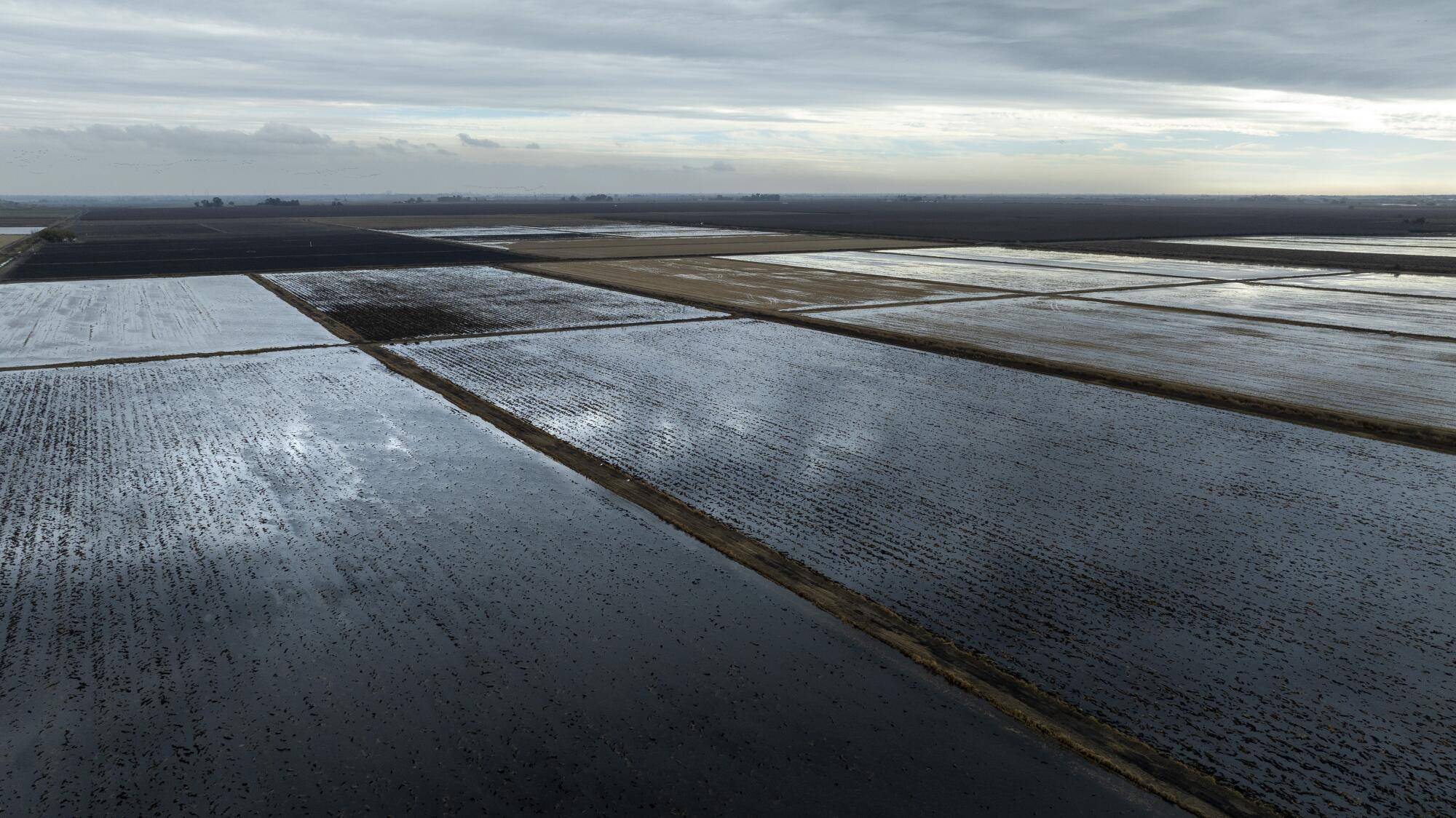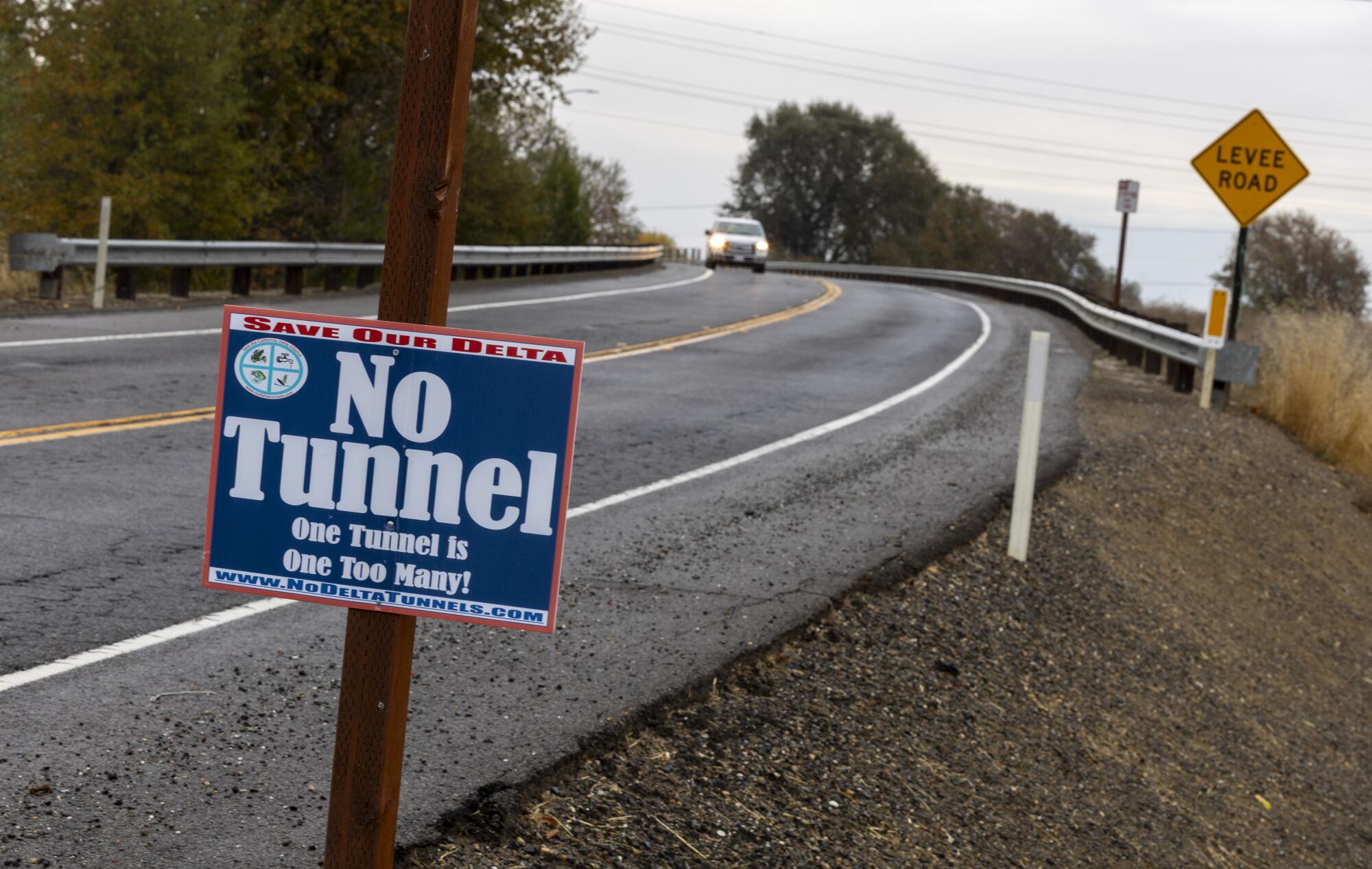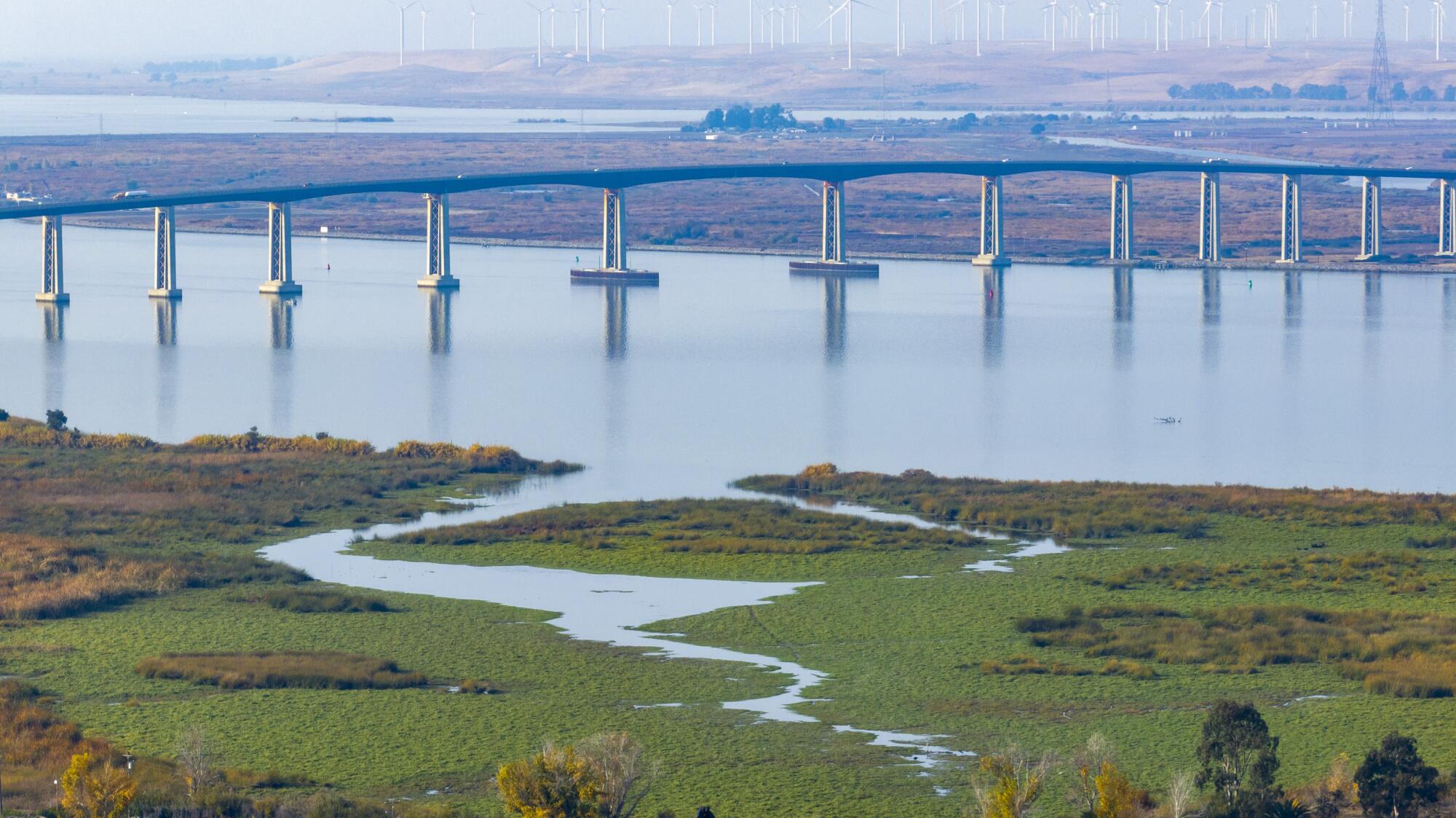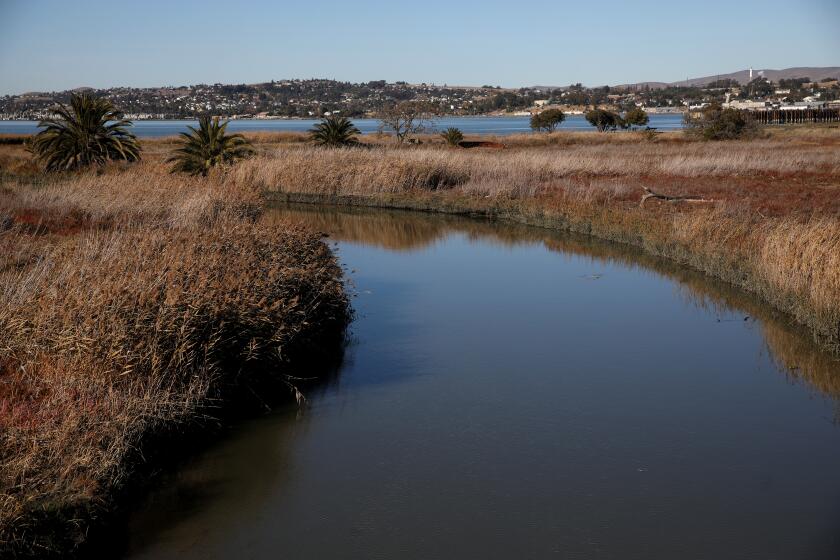
- Share via
Gov. Gavin Newsom’s administration announced that the estimated cost of building a tunnel to transport water beneath the Sacramento-San Joaquin River Delta has risen to $20.1 billion.
The estimate is part of a new cost-benefit analysis by the California Department of Water Resources, which concluded that the projected benefits of constructing the water tunnel would far outweigh the costs.
State officials released the analysis Thursday, saying the proposed Delta Conveyance Project is vital to improving the reliability of water supplies in the face of climate change, sea-level rise and the risks of an earthquake that could put existing infrastructure out of commission for months.
The state estimates that the project’s benefits would total nearly $38 billion by offsetting steep reductions in water deliveries due to existing infrastructure limitations and climate change.

“The project easily passes a benefit-cost test,” said David Sunding, a UC Berkeley emeritus professor who led the analysis as a consultant for the state. “The benefits clearly justify the costs.”
The last time the state produced an estimate, in 2020, the price tag came to $16 billion. The cost increase, Sunding said, is almost entirely due to inflation. The projected benefits also increased.
The cost analysis is the state’s latest step toward building the 45-mile tunnel, which would create a second route to draw water from the Sacramento River into the aqueducts of the State Water Project.
Newsom says the project is critical for California’s future, but opponents argue it is a costly boondoggle that would harm the delta and further imperil its ecosystem.
Environmental groups, Indigenous tribes, fishing organizations and local agencies have filed lawsuits seeking to block the project.
This week, dozens of groups filed protests with the State Water Resources Control Board challenging a state petition to change its “point of diversion” in the delta — one of the steps necessary to move forward with construction.
Opponents of the project said the state’s analysis is flawed and underestimates the costs while overestimating the benefits.
“The math is cooked,” said Barbara Barrigan-Parrilla, executive director of the group Restore the Delta, calling the analysis “nothing more than an elaborate public relations stunt.”
The Delta Conveyance Project is a key component of Gov. Gavin Newsom’s strategy for a hotter, drier California. Opponents say it will be an ecological disaster.
She said the state failed to adequately analyze the effects on local communities, tribes, the delta environment and the state’s fishing industry.
“Instead of foisting the costs of this boondoggle project onto Californians, the state should invest in sustainable water solutions that promise to restore the delta ecosystem, not destroy it,” Barrigan-Parrilla said.
Managers of water agencies and other supporters of the project said the state’s analysis shows it would be a cost-effective way of modernizing infrastructure to prevent damaging declines in the water supply.
“If we do nothing to shore up the State Water Project’s aging infrastructure, California’s primary and most affordable water supply faces continued reliability risk and remains vulnerable to increasing weather extremes,” said Jennifer Pierre, general manager of the State Water Contractors, an association of 27 public agencies.

The State Water Project provides a portion of supplies for 27 million people and about 750,000 acres of farmland — fueling a $2.3-trillion portion of the state’s economy.
But state officials say the state’s existing pumping infrastructure in the south delta, which draws water into the California Aqueduct, is vulnerable to the more intense extremes driven by climate change, as well as sea-level rise.
Aggressive and impactful reporting on climate change, the environment, health and science.
They estimate that if the state relies on its current infrastructure, there would likely be a 22% reduction in water deliveries by 2070. However, construction of the tunnel would boost supplies by an estimated 400,000 acre-feet annually, compared to the “no project” alternative.
The estimates included an analysis of impacts from sea-level rise — using scenarios of a 1.8 feet or 3.5 feet rise by 2070 — which would bring increasing risks of delta levees failing or being overtopped, and higher salinity water encroaching on existing infrastructure.
State officials also analyzed the risk that a major earthquake would pose to the existing infrastructure, which they say could disrupt deliveries of supplies for months. Sunding said the tunnel would have a “superior ability” to withstand earthquakes and would make the state’s system less vulnerable.

“I get a lump in my throat when I look at the potential for a catastrophic failure in the delta,” said Karla Nemeth, director of the state Department of Water Resources. “This is a project that just provides enormous value to the broad California economy.”
Nemeth said the analysis shows that doing nothing would mean substantial costs for the state through frequent water shortages, mandatory restrictions in cities, and reductions in agricultural supplies that would force farmers to leave fields dry and fallow.
“It is vastly more efficient and economical to avoid declining supplies,” Nemeth said.
The costs of the project would be paid for by urban and agricultural water districts that decide to participate.
The state’s cost-benefit analysis is intended to provide information that local water agencies, such as the Metropolitan Water District of Southern California, will consider as they study options for securing future supplies.
“The questions are, how can this project be implemented, what kind of assurances can we have in the resilience it provides to the Delta and our water supply future, and at what price?” said Adel Hagekhalil, general manager of the Metropolitan Water District.
The analysis, he said, will provide key information to help the MWD’s board members decide on future investments.

In preparing the updated cost estimate, the Delta Conveyance Design and Construction Authority examined potential “design and construction innovations” that could reduce the overall costs by about $1.2 billion.
Currently, about 56% of water deliveries from the State Water Project supply urban areas, while nearly 44% go to agriculture.
The analysis projects that with the tunnel, California would have fewer periods of mandatory water rationing and also less severe rationing, Sunding said. The project “helps to preserve the supplies that would otherwise be eroded through climate change,” he said.
State officials also compared the costs of additional supplies from the tunnel, at $1,325 per acre-foot, to the costs of additional supplies through investments in desalination, wastewater recycling, stormwater capture and conservation.
Gov. Gavin Newsom’s administration is advancing a plan to build a Sacramento-San Joaquin Delta water tunnel. Environmentalists are strongly opposed, warning of ecological damage.
Sunding said they found the median costs of these other types of investments would be higher, with the exception of conservation, which is “in the same ballpark” with the project.
“But it is important to note that we’ve done a lot of water conservation in the state, particularly in Southern California and some parts of the Bay Area, and a lot of the cheapest water conservation projects have already been done,” Sunding said. “So there are limits to how much more water conservation there can be.”
However, other experts say California still has a great deal of potential to continue reducing water use through conservation. Researchers with the Pacific Institute, a water think tank, found in a 2022 study that the state could reduce water use by more than 30% in cities and suburbs by investing in measures to use water more efficiently.
Opponents of the tunnel project have argued the state should instead invest in other approaches in the delta, such as shoring up levees and restoring natural floodplains to reduce flood risks, while changing water management to protect the estuary’s health.

Fish populations have suffered declines in recent years, and environmentalists say the tunnel would cause additional ecological harm.
State officials say the tunnel would lessen limitations on water deliveries linked to fish protections at the state’s existing pumping facilities in the south delta.
They point to this year as an example. Despite a wet winter and ample river flows, a rise in the deaths of steelhead trout and other fish in areas around the pumps forced reductions in pumping.
The Department of Water Resources said that if the delta tunnel had been in operation this year, an additional 909,000 acre-feet of water could have been delivered from intakes in the north delta, helping to resolve what officials described as “difficult conflicts” in the south delta.
“The status quo is not an option going forward. It’s just not something that can be maintained,” Sunding said. “One way or another, the system is going to change. Climate change is going to have its impact.”
While the state is seeking environmental permits, leaders of local water agencies are set to consider whether to participate in paying for the project. Nemeth said she and other state officials plan to reach a “potential decision point” for funding the project in late 2026.
The state’s plans call for starting construction in late 2029. Construction would take about 15 years, allowing the tunnel to begin delivering water in 2045.
A coalition called Californians for Water Security said the state’s report underscores the need to move forward with the project.
Jennifer Barrera, president and chief executive officer of the California Chamber of Commerce, said the project is a “real investment in California’s future” and critical for the state’s economy.
But environmental groups argue the state’s estimates of benefits are based on flawed assumptions.
Ashley Overhouse, a water policy adviser for the group Defenders of Wildlife, said rather than prioritizing the tunnel, the state Legislature should focus on developing a climate bond measure that would invest in other types of solutions rather than increasing reliance on an estuary that’s already in ecological decline.
Jon Rosenfield, science director for San Francisco Baykeeper, said he believes the state has underestimated the costs of building the tunnel and overestimated the costs of alternatives, such as conservation. He pointed out that state water regulators, after facing criticism, recently proposed conservation rules that would ease requirements for urban suppliers and lead to smaller statewide savings.
“There is a cheaper solution… and they’re not implementing it,” Rosenfield said. “The state is now telling you: We don’t need to save water. We’ll just build you a tunnel and get more water — from an ecosystem that’s collapsing because we take too much water from it.”
Other advocates have raised different concerns.
Deirdre Des Jardins, an independent water researcher, has warned that she believes the current design is flawed and that the tunnel intakes would be vulnerable to extreme flooding as well as sea-level rise.
She said she thinks if the state moves forward with the project, planners should consider moving the intakes. And she argued that the state’s analysis fails to adequately address the cost of raising delta levees to keep up with rising ocean levels.
“It’s a major vulnerability,” Des Jardins said.
“An extreme flood would flood that whole area, including the intakes,” she said. “You will get no water out if it’s flooded.”
However, state officials say the project is designed based on various scenarios of sea-level rise and extreme flooding, and would effectively mitigate risks.
“The more we start to understand the whiplash effects of climate, the more we understand the value of modernizing our infrastructure,” Nemeth said. “And our ability to design projects that provide affordable solutions has never been more critical.”
Toward a more sustainable California
Get Boiling Point, our newsletter exploring climate change, energy and the environment, and become part of the conversation — and the solution.
You may occasionally receive promotional content from the Los Angeles Times.












